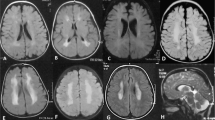Abstract
Alkaptonuria, the first human disorder recognized by Garrod as an inborn error of metabolism, is a rare recessive condition that darkens urine and causes a debilitating arthritis termed ochronosis. We have studied two families with consanguineous parents and four affected children in order to map the gene responsible for alkaptonuria. Coinheritance of either neonatal severe hyperparathyroidism or sucrase–isomaltase deficiency and alkaptonuria provided a candidate location for the mutated genes on chromosome 3. Homozygosity mapping with polymorphic loci identified a 16 centiMorgan region on chromosome 3q2 that contains the alkaptonuria gene. Analysis of two additional nonconsanguineous families supports linkage of alkaptonuria to this single locus (combined lod score = 4.3, θ = 0).
This is a preview of subscription content, access via your institution
Access options
Subscribe to this journal
Receive 12 print issues and online access
$209.00 per year
only $17.42 per issue
Buy this article
- Purchase on Springer Link
- Instant access to full article PDF
Prices may be subject to local taxes which are calculated during checkout
Similar content being viewed by others
References
La Du, B.N. in The Metabolic Basis of Inherited Disease (eds Stanbury J.B. et al.) 775–790 (McGraw-Hill, New York, 1986).
O'Brien, W.M., La Du, B.N. & Bunim, J.J. Biochemical, pathologic and clinical aspects of alcaptonuria, ochronosis and ochronotic arthropathy. Review of world literature (1584–1962). Am. J. Med. 34, 813–838 (1963).
Garrod, A.E. The Croonian lectures on inborn errors of metabolism. Lecture II Alkaptonuria. Lancet 2, 73–79 (1908).
Bateson, W. Mendel's principles of heredity (Cambridge University Press, Cambridge, 1902).
Smith, C. The detection of linkage in human genetics. J. Royal Stat. Soc. B. 15, 153–184 (1953).
Lander, E.S. & Botstein, D. Homozygosity mapping: a way to map human recessive traits with the DNA of inbred children. Science 236, 1567–1570 (1987).
Steinmann, B., Gnehm, H.E., Rao, V.H., Kind, H.P. & Prader, A. Neonatal severe primary hyperparathyroidism and alkaptonuria in a boy born to related parents with familial hypocalciuric hypercalcemia. Helv. Paediat. Acta. 39, 171–186 (1984).
Marx, S.J. et al. An association between neonatal severe primary hyperparathyroidism and familial hypocalciuric hypercalcemia in three kindreds. New Engl. J. Med. 306, 257–264 (1982).
Chou, Y.-H.W. et al. The gene responsible for familial hypocalciuric hypercalcemia maps to chromosome 3q in four unrelated families. Nature Genet. 1, 295–9 (1992).
Garnica, A.D., Cerda, J.J., Maenard, D., Preiser, H. & Crane, K. Alcaptonuria and sucrase-isomaltase deficiency in three offspring of a consanguineous marriage. Acta Vitaminol. Enzymol. 3, 157–169 (1981).
West, L.F., Davis, M.B., Green, F.R., Lindenbaum, R.H. & Swallow, D.M. Regional assignment of the gene coding for sucrase-isomaltase (SI) to chromosome 3q25–26. Ann. hum. Genet. 52, 57–61 (1988).
Swallow, D.M. et al. Analyses of linkage between SI (sucrase-isomaltase) and markers on chromosome 3. Cytogenet. Cell Genet. 58, 1881 (1991).
NIH/CEPH Collaborative Mapping Group.A comprehensive genetic linkage map of the human genome. Science 258, 67–86 (1992).
Weissenbach, J. et al. A second-generation linkage map of the human genome. Nature 359, 794–801 (1992).
Chantret, I. et al. Sequence of the complete cDNA and the 5′ structure of the human sucrase-isomaltase gene. Biochem. J. 285, 915–923 (1992).
Stenn, F.F., Milgram, J.W., Lee, S.L., Weigand, R.J. & Veis, A. Biochemical identification of homogentisic acid pigment in an ochronotic Egyptian mummy. Science 197, 466 (1977).
Alper, D.H. & Isselbacher, K.J. Disaccharidase deficiency. Advances in Metabolic Disorders. (eds Levine, R & Luft, R.) 73–122 (New York, Academic Press, 1970).
Naim, H.Y. et al. Sucrase-isomaltase deficiency in humans. Different mutations disrupt intracellular transport, processing, and function of an intestinal brush border enzyme. J. clin. Invest. 82, 667–679 (1988).
Anderson, M.A. & Gusella, J.F. Use of cyclosporin A in establishing Epstein-Barr Virus transformed human lymphoblastic cell lines. In vitro 20, 856–8 (1984).
Richards, E.J. Preparation and analysis of DNA. Current Protocols in Molecular Biology. (eds Ausubel F.M. et al.) (Greene Publishing, New York, 1992).
Ott, J. Analysis of human genetic linkage (Johns Hopkins University Press, Baltimore, 1983).
Author information
Authors and Affiliations
Rights and permissions
About this article
Cite this article
Pollak, M., Wu Chou, YH., Cerda, J. et al. Homozygosity mapping of the gene for alkaptonuria to chromosome 3q2. Nat Genet 5, 201–204 (1993). https://doi.org/10.1038/ng1093-201
Received:
Accepted:
Issue Date:
DOI: https://doi.org/10.1038/ng1093-201
This article is cited by
-
A robust bacterial high-throughput screening system to evaluate single nucleotide polymorphisms of human homogentisate 1,2-dioxygenase in the context of alkaptonuria
Scientific Reports (2022)
-
Homogentisate 1,2-dioxygenase (HGD) gene variants, their analysis and genotype–phenotype correlations in the largest cohort of patients with AKU
European Journal of Human Genetics (2019)
-
A father’s fight to help his sons — and fix clinical trials
Nature (2019)
-
Fatal methemoglobinemia complicating alkaptonuria (ochronosis): a rare presentation
Forensic Science, Medicine and Pathology (2018)
-
Weighted likelihood inference of genomic autozygosity patterns in dense genotype data
BMC Genomics (2017)



